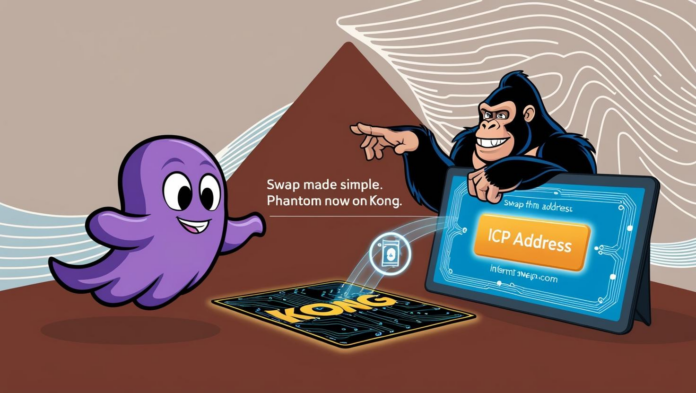Kongswap has opened the door for Phantom wallet users, and it’s not just a quick facelift. The update means direct swaps using Phantom—the wallet best known for playing nice with NFTs and DeFi—can now happen right on Kong. It’s simple, practical, and aimed at smoothing the edges between Solana natives and the Internet Computer ecosystem.
The idea is to allow people who’ve built their habits and portfolios on Solana to slip into Kong without fuss. By enabling Phantom wallet integration, Kongswap is tapping into one of Solana’s most trusted wallets. Phantom’s reputation has grown with the NFT crowd and DeFi tinkerers for its user-first design, its simplicity, and how it works across mobile and browser extensions without feeling like an afterthought. That same wallet now finds a home on Kong.
Once connected, Phantom users are automatically assigned an ICP address. This isn’t some half-baked workaround—it’s a native path for bridging their activity onto Kong’s turf. Rather than building a separate bridge or needing an extra interface, Phantom users get a ready-made ICP address. No long-winded wallet setups. No special tutorials. You connect, and you’re ready to go.
The move could be seen as a quiet nod to how Internet Computer projects are increasingly shedding their walled-garden approach. For all the talk about interoperability across crypto, few projects make it genuinely convenient. This step by Kong feels less like a marketing checkbox and more like a straightforward attempt to give people what they already expect in 2025—choice, ease, and speed.
It also speaks to Kong’s gradual evolution. At first glance, Kongswap has always leaned into its simplicity—focused swaps, no unnecessary clutter, and a sharp user interface. But under the hood, the project keeps building out subtle pieces that aim to rewire the assumptions about what’s possible in the DEX space on ICP. This Phantom integration is part of that rhythm—pulling more users into the ecosystem without asking them to abandon their existing tools.
For users who’ve spent time in the Solana space, this addition might come with a bit of nostalgia. Phantom’s rise was largely fuelled by the NFT craze of 2021, when it became the go-to wallet for minting, trading, and holding collections on Solana. Since then, it’s stayed in the loop by focusing on clean interfaces, faster speeds, and ensuring fewer things break mid-transaction. Bringing that same interface over to Kong adds a layer of familiarity for those walking in from the outside.
From a technical perspective, generating ICP addresses automatically when a Phantom wallet connects isn’t just a back-end trick—it reduces friction for onboarding. Instead of asking users to download an ICP-native wallet or figure out wallet chaining through multiple hops, they can just start. In a space where attention spans are short and trust is earned per click, that’s a strong play.
The timing of this update also gives some hints about where Kong might be heading next. Integrations like these are rarely done in isolation. They tend to follow or precede other changes—perhaps more wallets, maybe even cross-chain liquidity support. But more than speculating on the next feature set, this update quietly expands Kong’s presence. It shows that the team is watching where the users are and adjusting accordingly. That responsiveness matters.
There’s also an underlying message in how this update has been introduced. It’s not wrapped in over-engineered campaigns or dramatic claims. It just works. You connect your Phantom wallet, get your ICP address, and swap. In a market often obsessed with buzzwords and fanfare, Kong’s approach feels like a welcome contrast—functional, modest, and focused.
If you zoom out a little, the move says something about the bigger shifts happening across crypto platforms. The traditional lines between chains are beginning to blur, not just in theory but in daily interactions. Wallets like Phantom becoming usable on non-Solana protocols is part of that shift. It’s no longer enough to build great tools in isolation; those tools need to play well with others. Kong has picked up on that.
For developers and ecosystem watchers, it might be worth tracking how Phantom users behave on Kong. Will they stick around and explore deeper parts of the Internet Computer network? Will this integration lead to more NFT swapping or new DeFi patterns on ICP? Or will it just serve as a practical detour when needed? Whichever way it goes, the door is now open.
Kong’s own development arc has always leaned towards efficiency. While it hasn’t chased headlines at the same pace as some larger DEXs, it has built carefully, sometimes quietly. Its support for swaps, liquidity provision, and other core functions is steadily maturing, and this latest step extends that foundation outward. For users, that means fewer hoops to jump through. For Kong, it means a stronger chance at wider adoption.
It also gives Solana users a no-pressure invitation to test the waters on a different network. If you’ve been anchored to Solana but felt curious about Internet Computer, this offers a soft entry point. You don’t need to read whitepapers or scroll through Twitter threads to get started—you just connect your wallet and interact.
This small tweak has the potential to build wider bridges over time. Not everything in crypto has to be a full migration or dramatic move. Sometimes, just having one trusted tool work somewhere new is enough to spark fresh activity. Phantom on Kong could be one of those moments.
There’s still a lot to uncover in how Kong plans to expand this integration. Will there be support for more Solana-native assets directly on Kong? Could Kong eventually use this mechanism to allow Phantom users to stake or participate in ICP governance features? Those questions remain open, but they don’t need immediate answers to make this current update meaningful.
At its heart, this is about making decentralised finance easier. Crypto doesn’t need more barriers or more wallets. It needs things that click into place without drama. Phantom on Kong is a start in that direction.
If you’re a Solana user who’s toyed with the idea of trying out the Internet Computer space, this may be your cleanest starting point yet. No extra extensions, no fuss. Just connect, swap, and go. It doesn’t promise to change everything. It doesn’t need to. It’s a neat, useful addition—and one that’ll probably stick.


